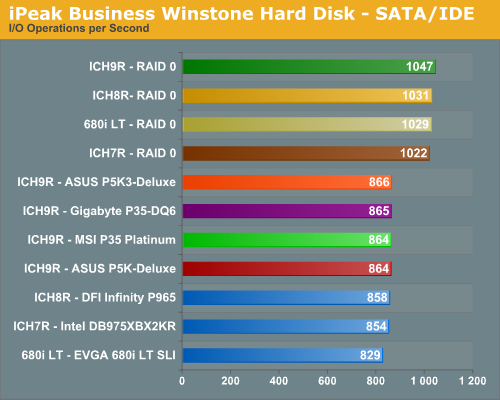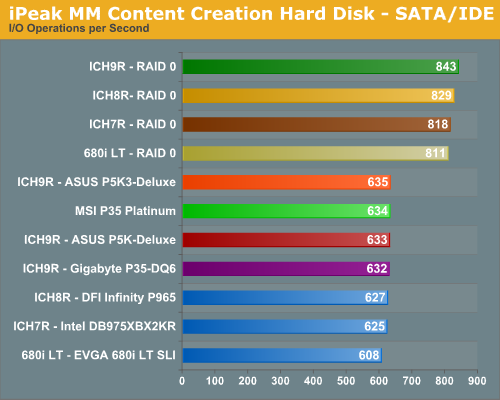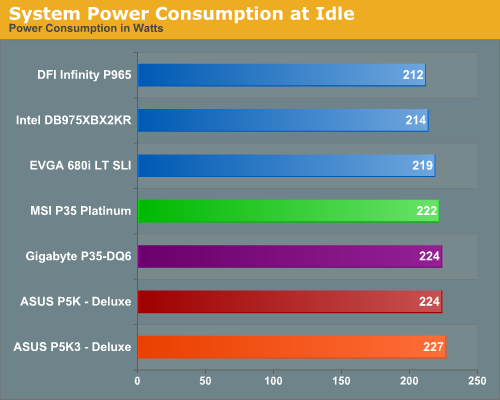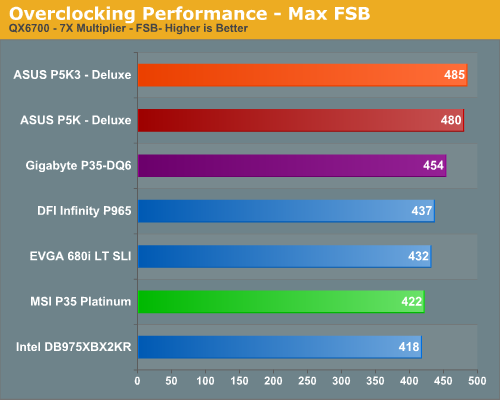Intel P35: Intel's Mainstream Chipset Grows Up
by Gary Key & Wesley Fink on May 21, 2007 3:45 PM EST- Posted in
- CPUs
Disk Controller Performance
The AnandTech iPeak test is designed to measure "pure" hard disk controller performance, and in this case we keep the hard drive as consistent as possible while varying the hard drive controller. The idea is to measure the performance of each hard drive controller with the same hard drive. We report the scores as an average number of I/O operations per second so that higher scores translate into better performance. This number is somewhat meaningless as far as hard disk performance is concerned; however, the scores are useful for comparing "pure" performance of the storage controllers in this case. Results are taken from trace files of Winstones 2004. Due to compatibility issues with Vista, our IPEAK tests are run on Windows XP SP2.

The performance patterns hold steady across both Multimedia Content I/O and Business I/O with the ICH9R outperforming the Intel ICH7R, Intel ICH8R, and NVIDIA 680i chipsets in our tests. Intel told us we should see up to a 4% difference between the ICH9 and ICH8; while our tests do not reveal that, we have noticed a difference in actual usage within Vista, especially when transferring large files. We will have Vista specific tests in the near future. Although our NVIDIA boards generally score lower in these "pure" throughput tests, we find their actual performance in disk intensive applications are generally equal to other solutions during actual usage. We did not experience any RAID 0 issues with the NV controller or drivers under Vista during normal usage but users have reported their RAID arrays degrading over time. We are still investigating these issues.
Power Consumption
As always, we measured power consumption at two states: at idle sitting at the Vista desktop and under load while running our 3DMark06 and Company of Heroes benchmarks. At both settings, EIST/C1E were disabled to show power usage with the system in a normal desktop state.


The surprise is that despite a 16W TDP, the P35 boards actually consume more power than the other chipsets at both idle and load. Even though the DDR3 board has a lower power rating for the memory, it consumes more power than the DDR2 board due to additional circuitry . We can no longer say that NVIDIA is the only high performance chipset approved by OPEC.
FSB Overclocking

Our FSB overclocking results are limited to the quad core QX6700 for this article. We will greatly expand our overclocking results for the roundup that will include five different CPUs. Our ASUS boards overclock the quad core the best at this time thanks to a fairly mature BIOS and great board design. Our Gigabyte and MSI boards have improved greatly over the last week with new BIOS designs and we expect overclocking to improve before the official launch date. In limited testing with the E6600, we were able to hit a 576 FSB on the ASUS boards, 514 on the Gigabyte board, and 508 on the MSI board with the latest BIOS releases.










58 Comments
View All Comments
drewintheav - Sunday, May 27, 2007 - link
When you tested the P5K Deluxe Wifi mainboard and OCZ Reaper 9200 ddr2 memory were you able to boot up with with both modules of the reaper memory installed or did you have to boot up with a different memory and then adjust the ddr2 voltage to 2.3?I can not boot with all settings on the Asus P5K Deluxe Wifi set to default. The motherboard starts up but the screen stays black and there is no beep or POST information displayed.
Were you able to boot up no problem? I was able to boot no problem at default settings on my Asus Commando with the same OCZ Reaper 9200. Do you think I need to replace my motherboard? I also have had the pc spontaneously restart twice now.
Thanks in advance for any info or suggestions that you can provide.
Stele - Tuesday, May 22, 2007 - link
Most sites seem to list Asus's high-end boards as having 8-phase power, as per the spec sheet provided by Asus. However, I've a funny feeling that it might not be so, despite the number of MOSFET "sets" and inductors. When I was working on P5B Deluxe boards, which also supposedly sports 8-phase power, I noticed that they used the Analog Devices ADP3198 synchronous buck controller. This controller supports up to 4 phases max, which suggests that the 8 apparent phases are actually arranged in two sets of 4-phase circuitry running in parallel. If this is true, it's an unfortunate bit of misleading marketing, though it was probably due to the pressure in keeping up with gimmicky competitors touting quantity (6-phase, 12-phase, xx-phase) over quality (component/circuitry design/implementation).The presence of a 'voltage damper' setting in BIOS for the P5Ks seem to hint at the possibility of something new, however: either the presence a new PWM controller or some additional droop compensation circuitry. I'm guessing it's still an ADP3198, and hence the latter scenario. Would it be possible to find out what controller's being used on the P5K, pretty please? :P
IMHO, while the Analog PWM controllers have generally been stellar performers in their own right, they ought to start improving their products so that manufacturers would have to worry less about breaking relationships with them and jump ship - especially with, for example, Intersil having excellent analog (up to 6 phases) and digital PWM controllers.
Stele - Wednesday, May 23, 2007 - link
Now that I recall, Gigabyte too is in the habit of being rather liberal with how they count phases... in fact they're arguably one of the first to do so, along with their DPS gimmick in the 875 days. The DQ6 is listed and marketed has having 12 phases, but if I remember correctly, Gigabyte uses an Intersil ISL6327 for their 12-phase products (at least the GA-965P-DQ6 did so). This is a 6-phase controller, which means that, as in the case of the Asus designs mentioned above, the "12-phase" power claimed by Gigabyte is little more than two sets of 6 phases in parallel. Is this still the case in the P35-DQ6?If so, it'd be good to point out the reality under misleading hype, so that if nothing else, readers and potential buyers are better informed - and to underscore the fact that there are hardware sites who do know their stuff and who don't simply swallow and parrot whatever the manufacturers throw at them.
Just my 2 cents'!
shabby - Monday, May 21, 2007 - link
The loop-de-loop kicks ass on the msi board :DTA152H - Monday, May 21, 2007 - link
I agree, I don't know why, but I need it!Gary Key - Tuesday, May 22, 2007 - link
It actually works also, a lot less aluminum than the Gigabyte and ASUS solutions, yet the MCH/PWM area seemed to be within 1C of the other boards in our early testing with the Quad. Still not a big fan of the "designs" coming out but to each his own. I think the new abit P35 board as the best looking heatpipe system but then I like it old school... :)TA152H - Wednesday, May 23, 2007 - link
I don't like you any more. I'm just not sure I can relate to someone that didn't like that rollercoaster :P .I expect it probably should work pretty well. With windmills, one of the biggest considerations for the power it produces is how tall the tower is; the further from the Earth, the more wind energy it will get. So, by extension, by creating this roller coast they elevate it to a higher point, and of course by convection the hottest air will hit that spot. So, it should work out pretty well (by now you're probably scratching your head thinking "what is this idiot talking about". It's because I have no clue, but I want it, and I'm making stuff up to validate the decision like this windmill nonsense).
Old school heat pipe systems? Hmmmm, I don't remember even seeing a heatsink on anything earlier than a 486 processor, so I just think we can categorize your heatsink taste, at best as prosaic, and maybe even boring! I think this roller coaster only portends of things to come, I expect bigger ones soon, as well a hot dog stand. Motherboards seem to have become amusement parks, we have carousels (spinning fans), water equipment, towers, and now a roller coaster. Good grief.
yyrkoon - Thursday, May 24, 2007 - link
Oh, and . . . .http://www2.abit.com.tw/page/en/motherboard/mother...">http://www2.abit.com.tw/page/en/motherb...pMODEL_N...
yyrkoon - Thursday, May 24, 2007 - link
I agree with Gary, these 'windmill' and butt ugly other heatpipes from other OEMs can not touch ABITs OTES in looks. I guess that is what hapens when you pioneer a technology, and everyone copies . . .Stele - Monday, May 21, 2007 - link
While the addition of 2 more USB 2.0 ports is certainly one of ICH9's new features, doesn't ICH8 already offer 6 SATA ports? That was one of the latter's welcome improvements over the ICH7.
There also doesn't seem to be anything in the block diagrams that indicate the presence of an eSATA port. I'm guessing here, but could it be that the mention of a "port multiplier" led to some confusion? After all, the 6 SATA ports in ICH8 and 9 are actually controlled by two host controllers, with internal port multipliers that connect them to 4 and 2 ports respectively (that's why, for example, some board manufacturers label two of the SATA ports as 'secondary' and state that it is generally not advisable to connect the boot drive to them).
However, I'm guessing that the port multiplier issue came up in the context of ICH9 because apparently Intel would be using only command-based switching in ICH9's port multipliers, removing FIS (Frame Information Structure)-based switching apparently used in ICH8 (most port multipliers use both command-based and FIS-based). While FIS-based switching offers higher performance under multiple-drive loads than command-based switching, FIS-based switching is more complex and hence expensive to implement; besides that, it uses slightly more CPU resources to manage the increased command and data flow rate. As such, Intel might have chosen to use the simpler, cheaper command-based switching for ICH9. If this is true, it might be to keep costs down and because many hardware sites probably over-emphasised on CPU-utilisation when comparing SATA performance with other chipsets. Argh. Again, this was something that came up on the grapevine but I've not been able to find official sources that verify or deny this... perhaps Anandtech could shed some light?
In the event that it's true, exactly how much performance would suffer under multiple-drive read/write loads is unclear, and this is where an extensive non-RAID and RAID performance test with perhaps a full six drives (or even 3/4/5) might give some hint. On the other hand, it may be that performance would not differ much in scenarios short of an array larger than a two-drive RAID 0/1 (as demonstrated in this review), so Intel decided to dispense with what they may consider a needless luxury.